Motorola Moto G7 Plus review: The most luxurious budget smartphone is back
Not content with the success of its three Moto G6 phones in 2018, Motorola has this year decided to unleash four low-priced G7 handsets. The new Moto G7 range attempts to cover the full breadth of the budget market, from the £149 Moto G7 Play right up to the luxurious £269 Moto G7 Plus that I’m reviewing here. Also up for grabs are the standard Moto G7 , launched at £239 along with a new addition to the range in the form of the Moto G7 Power (£179), which has a beastly 5,000mAh battery. All of them run on ‘stock’ Android 9 Pie.
The G7 Plus is the most expensive of the lot, of course, and veers dangerously close in price to a mid-tier smartphone. But do its extra features justify a higher price over the regular Moto G7? And is it really that much better than last year’s Moto G6 Plus?
READ NEXT: Best budget smartphones you can buy
Motorola Moto G7 Plus review: What you need to know
As you would expect, Motorola’s premium budget offering has the most impressive specifications out of the new Moto G7 lineup and on paper it’s much improved over last year’s Moto G6 Plus. Besides a larger 6.2in display than the G6 Plus’ 5.9in effort, the resolution has taken a minor boost. What’s more, there’s a brand new Qualcomm Snapdragon 636 to replace the 630 found in the Moto G6 Plus – the regular Moto G7 and Moto G7 Power have a Snapdragon 632.
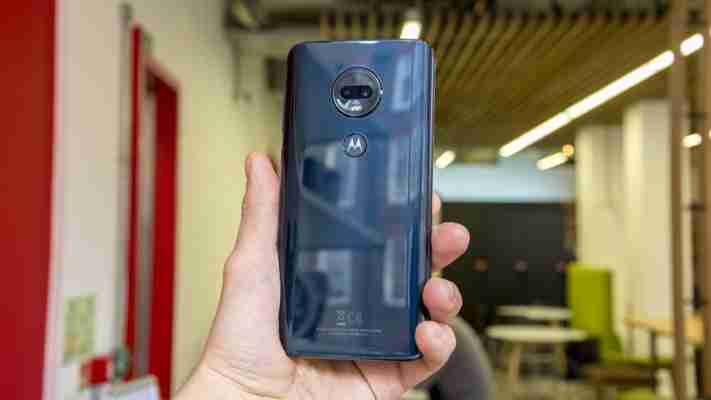
But the differences don’t end there, because the Moto G7 Plus can shoot 4K footage with OIS (optical image stabilisation). It’s a feature that the Moto G6 Plus lacked and an amazing inclusion for such a relatively cheap phone. The rear camera specs have changed too, as the Moto G7 Plus boasts a dual 16MP (f/1.7) and 5MP (f/2.2) setup, besting the 12MP and 5MP snappers on the outgoing model.
Buy now from Lenovo
The Moto G7 Plus comes with 4GB RAM and starts with 64GB storage, which can be expanded via Micro SD up to 512GB. All told, it’s a scarily formidable budget smartphone and a notable improvement on the G6 Plus. Yet I don’t find it as impressive as I did the G6 Plus last year, primarily because in 2019 the competition is so much fiercer.
Motorola Moto G7 Plus review: Price and competition
Motorola has kept the Moto G7 Plus fixed at £269 ; the same as the launch price of the G6 Plus. That’s particularly good news as it decided to mark the standard Moto G7 up to £239 from the Moto G6’s £220. So while the Moto G7 isn’t as much of a bargain as the Moto G6, the Moto G7 Plus is just as good value for money as its precursor, if not better.
The best deal to be had in Motorola’s G7 Range, however, is on the £179 Moto G7 Power , which costs £60 less than the regular Moto G7 despite running on the same Snapdragon 632 chip and possessing a near history-making battery life which puts most flagship smartphones to shame.

Last year we rated the Moto G6 Plus as the greatest phone you could buy under £300. Shop around now, though, and you’ll find there are some serious contenders that could steal the Moto G7 Plus’ crown. Take the HTC U12 Life , which not only shares its £269 price tag with the Moto G7 Plus but also its Qualcomm Snapdragon 636 processor. The two phones put out near identical performance scores too, though the U12 Life has the better battery life. Clearly, other manufacturers are out to knock Motorola off the top spot.

Much more dangerous to the Moto G7 Plus, however, is the Xiaomi Pocophone F1 . Since launch, it has dropped in price to just £300 , so if you’re willing to stretch a mere £30 beyond the Moto G7 Plus you could get a staggering increase in performance and battery life. The Pocophone F1 lacks OIS when shooting in 4K, mind you, so the Moto G7 Plus still holds some advantage.
Motorola Moto G7 Plus review: Design
There’s little separating the design of the Moto G7 Plus and Moto G7 aside from colour schemes. Holding the navy Moto G7 Plus next to the black Moto G7, it’s tough to tell the difference. Besides the colour, the dual LED flash on the Moto G7 Plus is the only giveaway. A fair amount has changed with this phone since last year’s Moto G6 Plus, though.
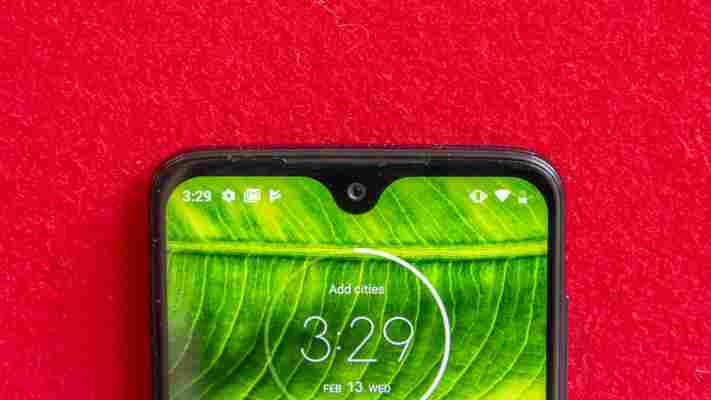
The first thing most people notice is that unsightly pimple-esque notch, which sacrifices elegance for a larger screen-to-bezel ratio. Indeed, the forehead and chin bezels have been reduced considerably, while the fingerprint reader has been relocated from below the screen to below the camera bump on the rear of the phone. I preferred last year’s design, frankly, but can’t deny that the Moto G7 Plus still looks incredible for its price, and I am especially fond of the red colour scheme.
Other changes are more subtle. The Moto G7 Plus is fractionally smaller, for example, measuring 157 x 75.3 x 8.3mm yet weighing 9g more than the Moto G6 Plus at 176g. It’s still made with the same aluminium frame encased on both sides by Corning Gorilla Glass 3, though, so it’s equally slick and shiny. There’s no waterproof rating on the Moto G7 Plus, unfortunately; Motorola says it’s “splash resistant”, but I don’t know how far they’re stretching that definition and I’m not going to find out by running the phone under a tap.
Another small change is to the camera bump on the rear. The protruding camera on the Moto G6 and Moto G6 Plus featured some nice metallic detailing. On this year’s models, there’s no detailing, only a smooth glass finish. Apart from the fingerprint reader, the button layout is unchanged, with the power and volume controls on the right edge of the phone. Up top, you have the dual SIM slot and 3.5mm audio jack, and at the bottom are the speaker grilles and USB-C charging port. The Moto G7 Plus comes boxed with a USB-C to USB-C cable.
Buy now from Lenovo
Motorola Moto G7 Plus review: Display
One more design change, which I mentioned earlier, is the size and resolution of the display. The 6.2in, 19:9 screen on the Moto G7 Plus is 0.3in larger than the 5.9in, 18:9 panel on the Moto G6 Plus, and there’s been a slight resolution bump up to 1,080 x 2,270 – it’s still just FHD, though. That said, Motorola has also updated the panel technology from IPS to LTPS; a newer form of LCD technology which is supposed to increase pixel density and reduce power consumption.
Provided you can get over the drop notch, it is a nice screen. In our display tests, it produced 90.8% of the sRGB colour gamut (about standard for a phone of this price) and has a solid maximum brightness of 386.6cd/m2. That’s still below par compared to the luminous 481cd/m2 of the standard Moto G7, which technically makes the older phone the superior phone for outdoor use, as it will suffer from less sun glare. On the flipside, the Moto G7 Plus has a significantly higher contrast ratio of 1,425:1, which lends greater vibrancy to images.
A Delta E average of 3.27 reflects the occasional colour inaccuracies; blues, purples and greens in particular are all oversaturated and look a little less natural. Out of the three display modes on the Moto G7 Plus, the Boosted setting is best because it is the most balanced and colour accurate.
Motorola Moto G7 Plus review: Performance and battery life
With the added expense and a more advanced chip, you’d expect the Moto G7 Plus to have the edge over the Moto G7 in terms of performance, but this doesn’t turn out to be the case. Perhaps this is to be expected. The octa-core Qualcomm Snapdragon 636 inside the Moto G7 Plus has the same 1.8GHz clock speed as the Snapdragon in the Moto G7, and both run on 4GB RAM.
Either way, the Moto G7 Plus barely outdid the Moto G7 in our benchmarks, achieving a multi-core CPU speed of 4,869 in the Geekbench 4 test whereas the Moto G7 reached 4,779 – a negligible difference.
As shown in the chart above the Moto G7 Power wasn’t even that far behind, yet it’s a full £90 less than the Moto G7 Plus. If you want more bang for your buck then the Moto G7 Plus is clearly the wrong choice. Instead, you might opt for Xiaomi’s Pocophone F1, which has a super-fast Qualcomm Snapdragon 845 and reached a multi-core CPU speed of 8,427. The Pocophone F1 is £300, and I think that’s not much of a price jump up from the Moto G7 Plus for such a significant performance boost.
Onto gaming, and the story is much the same; the Moto G7 Plus has near-identical gaming performance to the Moto G7 and G7 Power. In the GFXBench Manhattan 3 on-screen test, it maintained an average of 15fps, whereas the Moto G7 ran the same benchmark at 10fps. Again, the Pocophone F1 is the obvious frontrunner, running the Manhattan 3 on-screen test at an average of 59fps.
Using Gamebench I was able to measure the frame rate of two demanding smartphone games, Shadowgun Legends and PUBG Mobile. On the Moto G7 Plus, I was only able to set PUBG graphics settings to a maximum of Medium/Smooth, despite the Moto G7’s ability to run the same game in High/Smooth. Thus the Moto G7 ran a session of PUBG at a median of 30fps in High/Smooth settings while the Moto G7 Plus only managed 25fps, with a 97% frame rate stability. The reason? Presumably, the game cannot recognise the newer Snapdragon 636 chip so it set a frame rate limiter.
The Moto G7 Plus had a happier time with Shadowgun Legends on Low settings, where it reached peaks of 60fps and maintained a median of 33fps. Frame rate stability was all over the place at 59%, but at least the Moto G7 Plus outperformed the Moto G7, which ran Shadowgun Legends on the same settings at a median of 28fps. Granted it’s not a big difference, but it’s a more accurate depiction of graphical ability than the PUBG Mobile test.
The only aspect of performance that has backtracked since last year’s Moto G6 Plus is battery life. In our standardised battery life rundown test the Moto G7 Plus lasted for a disappointing 10hrs 20mins worth of video playback. That’s 3hrs 50mins less than the Moto G6 Plus, with the increased display size at least partly to blame. Meanwhile, the new Moto G7 Power lasted a sensational 26hrs 22mins thanks to its 5,000mAh battery. By comparison, the Moto G7 Plus looks positively feeble.
READ NEXT: Best smartphone battery life
Motorola Moto G7 Plus review: Camera
The Moto G7 Plus camera isn’t all that different to that of the Moto G6 Plus. The rear camera is a dual 16MP (f/1.7) and 5MP (f/2.2) setup versus last year’s 12MP (f/1.7) and 5MP (f/2.2). Video capabilities have been improved, however, with the introduction of optical image stabilisation for smooth 4K recording.
Motorola made a big song and dance about this feature at the product launch in Brazil, and rightly so; a sub-£300 handset with OIS is rare indeed. To test the stability, I took a video and panned at high speeds in various directions. The footage was impressively stable, although there is a degree of noise (or graininess) to the recording which calms down when the camera stops moving about.
Photo quality is outstanding for a handset of this price but the same can be said of the standard Moto G7, which has a 12-megapixel (f/1.8) and 5-megapixel (f/2.2) dual camera. What better way to measure the quality of the Moto G7 Plus snapper than to pit it directly against its cheaper sibling?
Looking at this blown up comparison of the same outdoor scene, taken seconds apart on the Moto G7 Plus (left) and Moto G7 (right). There’s hardly any difference between the two shots, both of which were taken in HDR mode. Detail is about the same. You may notice that the Moto G7 Plus’ colours have more vibrancy, which is most prominent in the red, yellow and green surfaces on the scene.
It’s not easy to say which one is better, really, but both are excellent. I will say that the colours on the Moto G7 appear slightly more ‘real’, whereas the Moto G7 camera seems to exaggerate the colours, producing an oversaturated look.
Outdoor picture quality might be roughly equal between the Moto G7 Plus and Moto G7, but in low light conditions, the former is the clear winner. Examine the side-by-side image above; there is more detail and greater definition to the teddy bear fur, and it suffers from less colour bleed and noise – around the toy train and paint palette, for example. The wider aperture on the Moto G7 Plus lets in more light, which makes it the better camera in poor lighting situations, as shown above.
The front-facing 12MP camera on the Mot G7 Plus is a nice bit of kit too, with its own 4K filming capabilities, albeit this time without OIS. There are some handy AI features in the camera software this year, including an auto-shooting setting that takes a photo when a smile is detected. This only works when it picks up a nice row of teeth, however, and closed-mouth smiles won’t trigger it. Google Lens has also been built-in, saving you time from having to open up a separate app.
Buy now from Lenovo
Motorola Moto G7 Plus review: Verdict
For years, Motorola’s budget Moto G series has dominated the budget handset market, leaving little room for rival manufacturers. The times are changing, though, with the likes of Xiaomi, Honor and HTC moving in on Motorola’s turf. What’s more, the premium devices in the range (the Moto G7 and Moto G7 Plus) aren’t even the best. No, in terms of value for money the best Motorola phone is evidently the Moto G7 Power, which has similar performance to the regular Moto G7, near record-breaking battery life and costs £60 less.
Is it worth buying the Moto G7 Plus at all when the Moto G7 Power costs £90 less and the Xiaomi Pocophone F1 is a mere £30 more? Perhaps, but it depends on what you’re looking for. If you’re happy to settle for a non-FHD display and a weaker camera then the Moto G7 Power is the phone for you. Likewise, if you value battery life above all else. And if it’s speed and power you’re after, you’ll be best served with the Pocophone F1.
Yet this still leaves one thing you can’t get even with the Pocophone F1: the ability to shoot in 4K with OIS. While it’s not the best deal out there, the Moto G7 Plus still has about the best smartphone camera you can get for less than £300.

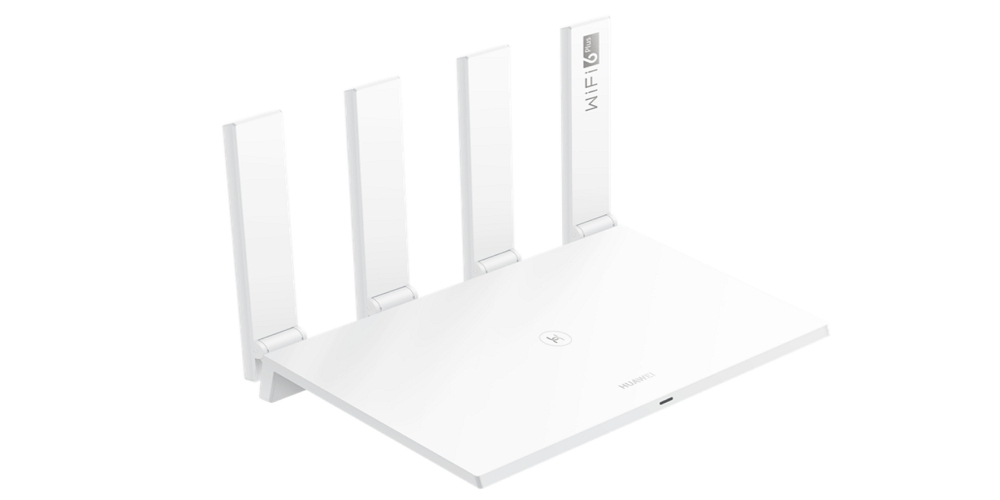
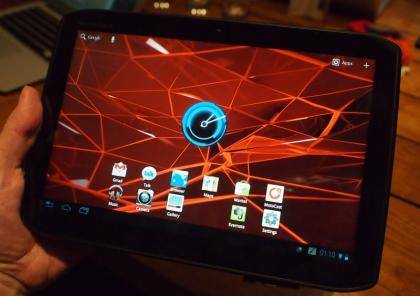
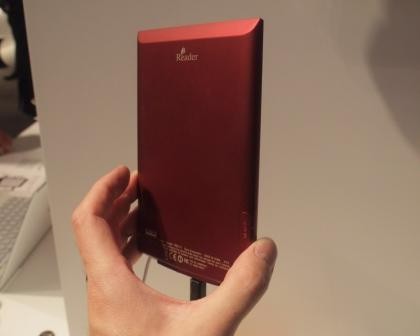
Leave a Comment